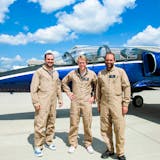WASHINGTON – Designers of futuristic cityscapes envision delivery drones dropping off your packages from the sky and driverless cars taking you to work. But the robotic delivery invasion already has arrived in the form of machines that look like beer coolers on wheels scooting along the sidewalks.
The ground-bound robots, developed by the science fiction-sounding company Starship Technologies, will be showing up any day in the nation's capital and in Redwood City, Calif. They could soon be in up to 10 cities, ferrying groceries and other packages over what the company calls the "last mile," from a neighborhood delivery "hub" to your front door, all for as little as $1 a trip.
A second company, TeleRetail, plans to test its sidewalk robots in Washington and other cities, including Mountain View, Calif., next year.
Like driverless cars, the delivery robots use cameras, GPS and radar to "see" their urban environment and navigate through it.
The robots are the first of what the companies foresee as a wave of inexpensive, high-tech, electricity-driven alternatives to gasoline car-driven shopping trips and delivery trucks that contribute to traffic gridlock and pollution. Urban futurists see the little robots as an integral part of a digitally based "smart city" landscape — although it will take time for humans to adjust to them, and they come with privacy concerns.
"We think there will be hundreds, if not thousands, of robots on the ground eventually around the world," said Allan Martinson, chief operating officer of Starship Technologies, based in London and started by the co-founders of internet telephone company Skype.
Torsten Scholl, founder of TeleRetail, which is based in Switzerland, said, "Why have a vehicle as big as an autonomous car to deliver goods? We think of it as a self-driving trunk."
And tech gadget website Tech Crunch has called autonomous vehicles — like drones, driverless cars and delivery robots — among the "Top Five Technologies" that will define cities in the next decade.


